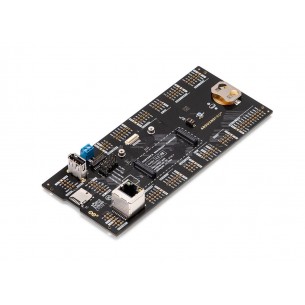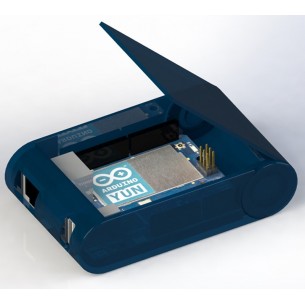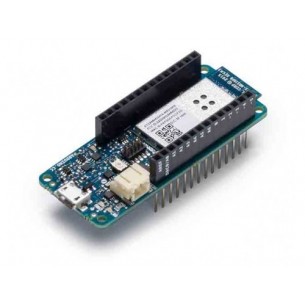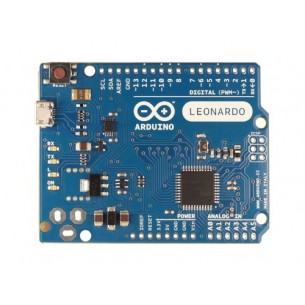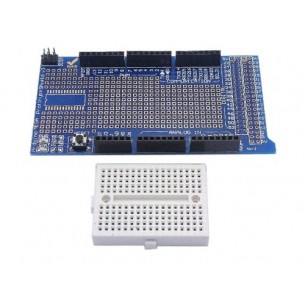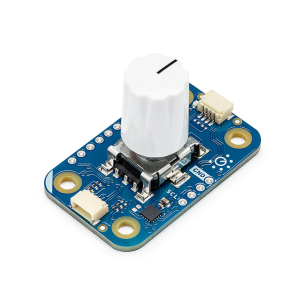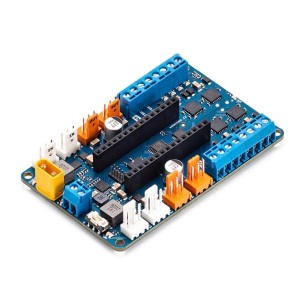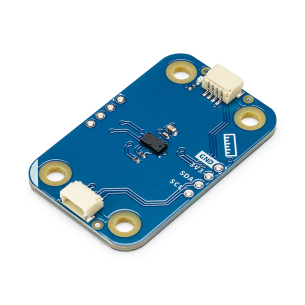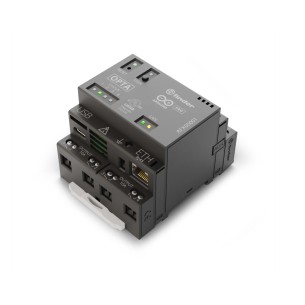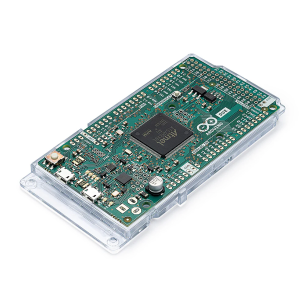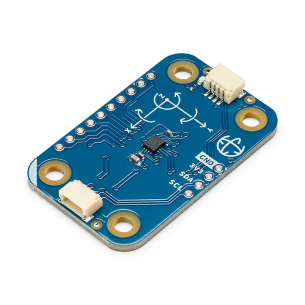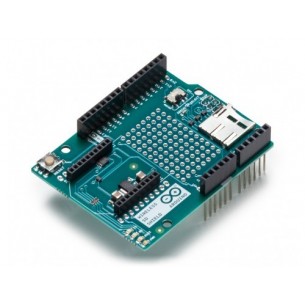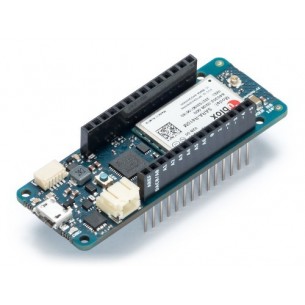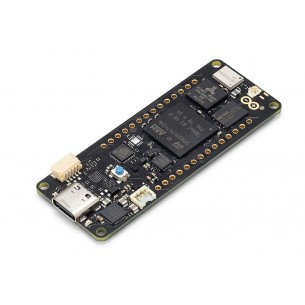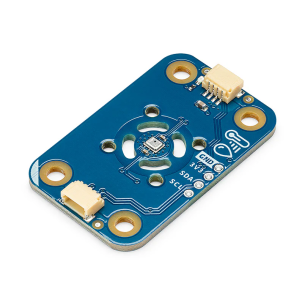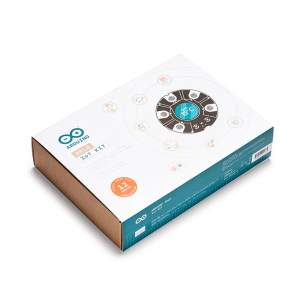A touchscreen module designed for implementing graphical interfaces in projects based on Arduino GIGA. It is equipped with a 3.97-inch display with a resolution of 480 x 800 pixels and a 5-point touch panel, as well as an IMU sensor and a microphone. Arduino ASX00039
List of products by brand Arduino
Innovation with Arduino: The Creator of the Technological Revolution
Arduino is a brand that has revolutionized the way we approach learning electronics, programming, and embedded systems design. Since its inception, Arduino has become synonymous with innovation, simplicity, and accessibility of technology. Its products are used in both education and professional engineering projects, making it a leader in the microcontroller market.
There are 94 products.
The module with connectors is dedicated to the Arduino Portenta boards. It helps in prototyping and testing connections. Arduino ASX00031
This blue case from Arduino is specifically for the Arduino Yun and Arduino Yun with PoE boards. The case has easy access to all board connections. M000008
Arduino MKR1000 Wifi with Headers
Board with nRF52840 microcontroller with Cortex M4F core (64 MHz, 1 MB Flash, 256 kB RAM). Equipped with BT 5.0 and IMU LSM9DS1 module. Arduino ABX00030
Development board with ATmega32u4 microcontroller (AVR), 20 I / O lines, 7 PWM channels, 16 MHz quartz, micro-USB. Easy-to-use USB support libraries, sensors, displays, etc. are available. A000052
Module with dual-core STM32H747XI microcontroller with CortexM7+M4 core equipped with 2 MB flash memory, 1 kB RAM and clock speeds up to 480 MHz. The board has a built-in WiFi module and Bluetooth 5.1 (Murata 1DX). Arduino ABX00042
Prototype board for Arduino with Mini Bread Board
This module combines the functions of a precision rotary knob with a pushbutton, ideal for control in IoT projects, home automation, and user interfaces. Equipped with a PEC11J encoder and an STM32C011 chip, it provides accurate position readings and real-time click recording via I2C/Qwiic. Supported by Arduino Cloud and a dedicated library, it allows both beginners and advanced developers to get started quickly. Arduino ABX00107
Nano Motor Carrier to moduł rozszerzeń przeznaczony do Arduino Nano 33 IoT, który został zaprojektowany, aby ułatwić sterowanie silnikami. Pozwala na kontrolowanie ruchu czterech silników prądu stałego, ale można go również wykorzystać do podłączenia serwomechanizmów i czujników. Arduino ABX00041
This intelligent distance measurement module, based on the VL53L4CDV0DH/1 sensor, offers a range of up to 1200 mm with ±3% accuracy and 1 mm resolution. Its plug-and-play design and Qwiic connectors integrate seamlessly with the Arduino® ecosystem, supporting the Arduino Cloud and Modulino® library. Its low power consumption makes it ideal for mobile and IoT applications, while its compact design eliminates the need for soldering. Arduino ABX00102
A compact sound module that lets you quickly add tones and acoustic effects to your electronics projects. Based on the PKLCS1212E4001-R1 buzzer and an STM32C011 microcontroller, it communicates via I2C/QWIIC, ensuring easy integration with Arduino and MicroPython. Support for the Arduino Cloud and a dedicated library make the module suitable for both beginners and advanced makers. Arduino ABX00108
Arduino Opta is an advanced, safe and easy-to-use micro-PLC controller that makes it easy to add Internet of Things (IoT) capabilities to industrial applications. It can be programmed using languages known from PLC devices. It was developed in cooperation with Finder and is an ideal tool for PLC engineers. Arduino AFX00001
Arduino DUE is a board with an Atmel SAM3X8E microcontroller (ARM, Cortex-M3 core) clocked at 84 MHz. The user has 54 I/O lines (including 12 PWM channels), 12 analog inputs, 2 digital-to-analog converters. Version without soldered connectors. Arduino A000056
A compact module for recording tilt, rotation, and pitch, based on the precise LSM6DSOXTR sensor. Plug-and-play and Qwiic connectors enable quick connection to the Arduino® ecosystem, eliminating soldering and complex configuration. It supports the Arduino Cloud and the dedicated Modulino® library, allowing you to launch your first projects in minutes. Ideal for education, IoT, prototyping, and interactive installations, it offers full integration and easy system expansion. Arduino ABX00101
A wireless overlay designed for Arduino tiles. Equipped with a connector compatible with Xbee modules and a microSD card slot. Arduino A100065
Development board with SAMD21 microcontroller (ARM Cortex® M0+), 22 I / O lines, 12 PWM, UART interfaces, I2C, SPI. The board is equipped with the UBLOX SARA-R410M-02B module enabling the implementation of communication in NB IoT networks. Arduino MKR NB 1500 ABX00019
Module with dual-core STM32H747XI microcontroller with CortexM7+M4 core equipped with 2 MB flash memory, 1 kB RAM and clock speeds up to 480 MHz. The board has a built-in WiFi module and Bluetooth 5.1. Arduino ABX00046
This HS3003 sensor-based measurement module provides precise temperature (-40°C to +125°C, ±0.25°C accuracy) and humidity (0–100% RH, ±2.8% accuracy) measurement. Plug-and-play functionality, Qwiic connectors, and Arduino Cloud support make it easy to integrate into projects, eliminating the need for soldering. The module\'s low power consumption and 14-bit resolution make it ideal for IoT systems, building automation, precision agriculture, and education. Arduino ABX00103
A kit that allows you to add connectivity to devices at home or in the workplace. It consists of Arduino MKR WiFi and the MKR IoT Carrier base board and contains a complete set of 8 Internet of Things projects, ready for self-assembly. Arduino AKX00026
History and Vision of Arduino
Arduino was founded in 2005 by a group of technology enthusiasts from the Interaction Design Institute Ivrea in Italy. The project's main goal was to create a platform that would enable students to easily and affordably learn the basics of electronics and programming. Thanks to its openness and accessibility, Arduino quickly gained popularity worldwide, becoming the foundation for many DIY projects and professional prototypes.
Most Popular Arduino Products
Arduino offers a wide range of products that differ in capabilities and applications. One of the most recognizable models is the Arduino Uno. This is one of the most popular models, ideal for beginners. Equipped with the ATmega328P microcontroller, it has 14 digital inputs/outputs and 6 analog inputs. Due to its simplicity and versatility, the Uno is often chosen for learning the basics of programming and electronics. Another model is the Arduino Mega, designed for more advanced projects. The Mega offers a larger number of inputs/outputs (54 digital and 16 analog) and a more powerful ATmega2560 microcontroller, making it ideal for resource-intensive projects such as robotics and home automation. Arduino Nano is a compact and efficient model that can be easily integrated into small projects. The Nano features an ATmega328 microcontroller and is an excellent choice for portable projects and wearable devices. Another interesting model is the Arduino Leonardo, which stands out with its built-in USB functionality, allowing it to function as a mouse or keyboard. This is an excellent tool for creating interactive installations and projects requiring computer integration. The Arduino MKR series was created with IoT projects in mind. Models like the MKR1000 offer built-in WiFi connectivity, making it easier to create smart devices and remote monitoring systems.
Specialization and Technological Advancement
Arduino is not only an educational platform but also an advanced tool for professionals. With support for various programming languages such as C++, Python, and JavaScript, as well as the ability to integrate with different operating systems and cloud services, Arduino is extremely versatile. Advanced modules and extensions, such as sensors, communication modules, and actuators, enable the creation of complex systems, from simple IoT devices to advanced industrial automation systems. Additionally, Arduino supports many development platforms and libraries, facilitating integration with modern technologies such as artificial intelligence and data analysis.
Community Support and Education
One of the key elements of Arduino's success is the vast community of users who actively support the platform's development and popularization. With thousands of available projects, tutorials, and discussion forums, users can quickly find help and inspiration for their ideas. Arduino places a strong emphasis on education, offering a wide range of educational materials, starter kits, and online courses. This allows both teachers and students to easily embark on a journey into electronics and programming, fostering creativity and analytical skills.
Applications and Future of Arduino
Arduino finds applications in many fields, from education and hobbyist DIY projects to advanced industrial systems. In education, Arduino is used as a tool for learning the basics of engineering and programming, enabling students to create their own projects and experiment with new technologies. In industry, Arduino is used for rapid prototyping and testing new solutions, allowing companies to bring innovations to market more quickly. With support for IoT, Arduino plays a key role in developing smart systems such as smart homes, energy networks, and environmental monitoring systems. The future of Arduino looks equally promising. With the ongoing development of new technologies and increasing availability of resources, Arduino remains at the forefront of the technological revolution, inspiring future generations to explore and create.
Why Does Arduino Stand Out in the Market?
Arduino stands out from the competition due to its simplicity, openness, and versatility. Its products are not only easy to use but also extremely flexible, allowing them to be applied in a wide range of projects. By offering a broad range of products, community support, and educational materials, Arduino has become an indispensable tool for anyone wanting to delve into the world of technology. In summary, Arduino is not just a brand but also a community that supports innovation and technological development worldwide. Its products and philosophy of making technology accessible to everyone ensure that Arduino remains a leader in electronics and programming, opening up new possibilities and inspiring the creation of the future.


